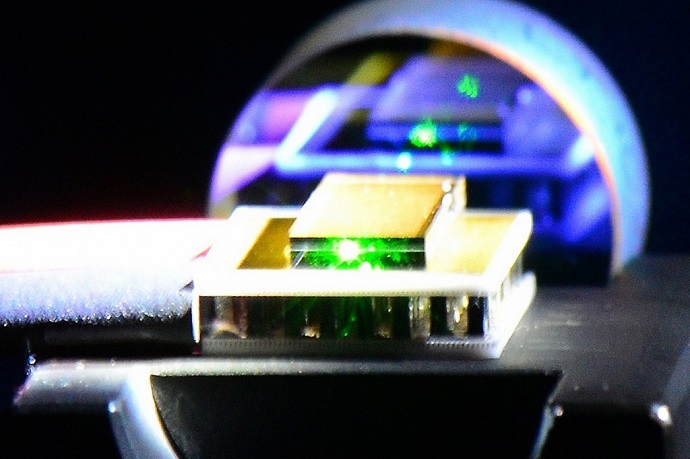5 May 2014
For the first time, researchers have shown that diamond can radically improve the quality of high power laser beams, according to new photonics research published overnight in Laser & Photonics Reviews. A team from the Macquarie Photonics Research Centre have demonstrated this improvement by exploiting optical interactions inside a diamond crystal of length several millimetres long.
“Lasers come in all sorts of colours and with beam powers that range from the milliwatt level we are familiar with in laser pointers and in DVD players, up to many thousands of watts, enough to burn through steel in a fraction of second,” says lead researcher Dr Aaron McKay.
However, there is one fundamental property of a laser beam that is critical to applications – its quality, or, in the terminology of physicists, its coherence. High quality lasers are needed to meet growing technological demands in applications as diverse as in materials processing, environmental and remote sensing, and in defence.
Beam quality and brightness are fundamental attributes that inherently make lasers so valuable.
“Standard methods used to increase beam brightness involve converting the beam in a second laser – a “laser converter” – which inevitably leads to an overall loss of power. This may be acceptable at low powers but not at the higher powers in which the large heat dissipated in the converter spoils the process,” McKay says.
Crucially, the device used by McKay and colleagues was highly efficient so that the brightness of the output beam was 50% higher than the input beam.
The major advantage of using diamond is its outstanding ability to dissipate heat – faster than other optical materials and for conversion to be achieved passively in a very small package.
“Diamond is a very exciting laser material,” says McKay, “Its properties in so many aspects are so much better than other materials that there are likely to be massive opportunities for greatly improving laser capability.”
This beam conversion occurs using a process called stimulated Raman scattering; a phenomenon studied in diamond at Macquarie University extensively for the past five years, as reviewed by Mildren and colleagues in the new book Optical Engineering of Diamond. “The Raman process not only improves the beam quality but also converts the colour of the laser beam,” he says.
This very useful property has enabled the researchers to demonstrate the simultaneous conversion of a high power laser with poor beam properties to a bright beam in a part of the infrared spectrum called the eye-safe region. Lasers in this part of the spectrum are in great demand for applications that require field use of laser beams such as in environmental sensing and in defence.
With this proof of concept, and patent protection, the researchers now plan to take the research further to demonstrate conversion of high powers or with other colour (wavelength) lasers. A further attractive advantage enabled by diamond is, because it is highly transparent across an extremely broad spectrum, converters can be made to generate a wide range of laser colours and applications.
The work was supported by the Asian Office of Aeronautical Research and Development.
Simultaneous brightness enhancement and wavelength conversion to the eye-safe region in a high-power diamond Raman laser, Aaron McKay, Ondrej Kitzler and Richard P. Mildren, DOI: 10.1002/lpor.201400012
Source:
http://mq.edu.au/newsroom/2014/05/05/diamond-makes-laser-beams-more-brilliant/














